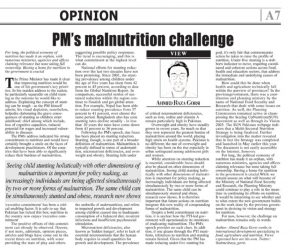The Prime Minister has made it clear that improving nutrition would be one of his government’s key priorities. In his maiden address to the nation, he particularly squaredin on child stunting as the outcome he would like to address. Explaining the concept of stunting can be tough – as the PM himself admits; his visual depiction, nonetheless, helpedin elaborating the grave consequences of stunting as children enter adulthood: chief among which include, loss of cognitive capacities, reduced potential for wages and increased vulnerability to diseases.
The PM’s address indicated his strong commitment to nutrition and would have certainly brought a smile on the faces of development practitioners. Of the countries that have been able to significantly reduce their burdens of malnutrition, ‘executive commitment’ has been a critical enabling factor. It is safe to say that Pakistan has ticked this box; nutrition in the country now enjoys ‘executive commitment’.
The positive effects of this commitment can already be observed. Dozens, if not more, editorials, opinion pieces, articles and blogs have come out in the recent times on nutrition, with some providing the state of play and others suggesting possible policy responses. The trend is encouraging, and this is what commitment at the highest level can do.
“Seeing child stunting holistically with other dimensions of malnutrition is important for policy making, as increasingly individuals are being affected simultaneously by two or more forms of malnutrition. The same child can be simultaneously stunted and obese, research now shows.”
National efforts for stunting reduction over the last two decades have not been promising. Since 2001, the stunting prevalence among children under the age of five years has risen from 42 percent to 45 percent, according to data from the Global Nutrition Report. In comparison, successful stories of sustained reduction within the region continue to flourish and get global attention. For example, Nepal has been able to reduce stunting prevalence from 57 percent to 41 percent, over almost the same period. Bangladesh also has seen stunting rates decline steadily – in less than 10 years the rates have come down from 43 percent to 36 percent.
Following the PM’s speech, due focus has been placed on stunting reduction. Stunting, though, is one part of a broader definition of malnutrition. Malnutrition is typically defined in terms of undernutrition, micronutrient deficiencies, and overweight and obesity. Stunting falls under the umbrella of undernutrition, and refers to impaired growth and development among children caused due to inadequate consumption of a balanced diet, recurrent infections and insufficient psychosocial stimulation.
Micronutrient deficiencies, also known as ‘hidden hunger’, refer to lack of essential micronutrients that the human body requires in small quantities for growth and development. The prevalence of critical micronutrient deficiencies, such as iron, iodine and vitamin A remain particularly high in Pakistan.
Overweight and obesity have steadily grown in recent years. So much so that they now represent the greatest burden of malnutrition around the world, placing high strain on health systems. Pakistan is no different; the rate of overweight and obesity has been on the rise especially in urban settingsand among adolescent girls and women.
While attention on stunting reduction is essential, considerable focus should also be placed on other dimensions of malnutrition. Seeing child stunting holistically with other dimensions of malnutrition is important for policy making, as increasingly individuals are being affected simultaneously by two or more forms of malnutrition. The same child can be simultaneously stunted and obese, research now shows. It is therefore important that future actions on nutrition integrate this new reality of compounding forms of malnutrition.
Despite a bold commitment on nutrition, it is unclear how the PTI-led government will operationalize its intentions of eradicating malnutrition. The PM’s speech provides no such clues. In addition, if one gleans through the PTI manifesto, references to nutrition and stunting remain limited. Given that the PM has made reducing under-five stunting his goal, it’s only fair that commensurate action be taken to raise the profile of nutrition. Under-five stunting is a stubborn indicator to move, requiring coordinated and coherent actions across food, health and education sectors, that address the immediate and underlying causes of malnutrition.
How could this be done when health and agriculture technically fall within the purview of provinces? In the previous government, there was a coordination and planning ministry by the name of National Food Security and Research that dealt with some issues on nutrition. As well, the Planning Commission remained active in championing the Scaling Up Nutrition(SUN) movement as well as through its Vision 2025. The SUN Pakistan webpage indicates that a Multi-Sectoral Nutrition Strategy is being finalized. Further investigation into the matter revealed that in fact the Strategy was completed and launched in May earlier this year. The document is not easily accessible on the internet, however.
For long, the political economy of nutrition has made it an orphan, with numerous ministries, agencies and offices claiming relevance but none taking full ownership. Having a home for nutrition in the government is crucial.While we remain unsure on what will become of the Ministry of National Food Security and Research, the Planning Ministry could continue to play a role in the meantime in continuing its efforts on nutrition. It would be interesting to see whether and to what extent the new government builds on the work done by the previous government in devising its vision and strategy for nutrition.
For now, however, the challenge on malnutrition remains only in words.
Author: Ahmed Raza Gorsi works in international development specializing in food, agriculture and nutrition. Views expressed here are his own. Twitter: @ahmedraza_gorsi.
